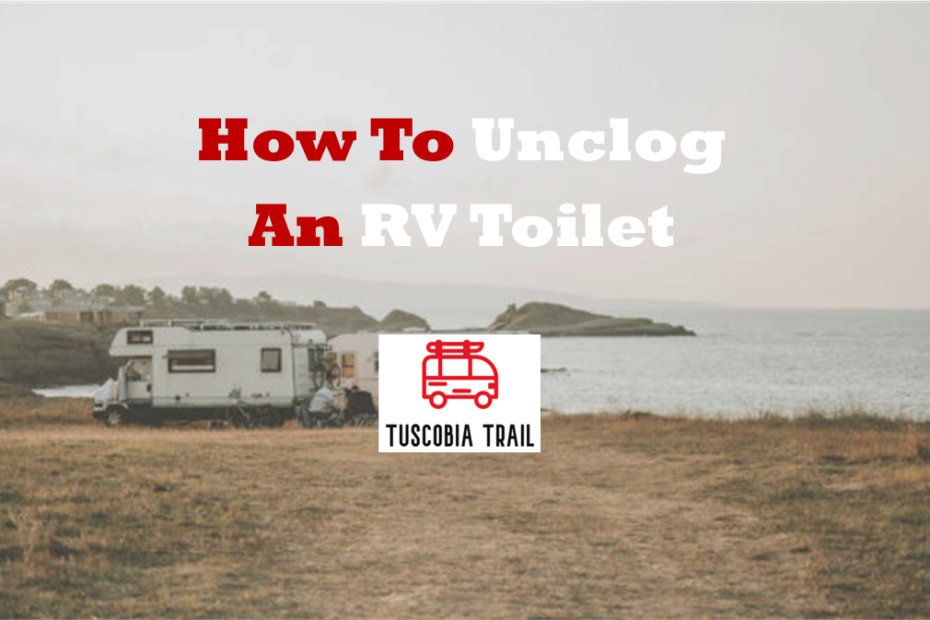To unclog an RV toilet, it’s crucial to understand the unique challenges of RV toilet clogs. We’ve encountered this problem many times so it is important to know how to fix the issue.
Unlike home toilets, the RV septic system demands specific care to prevent backups. When you unclog a toilet in an RV, you’re dealing with holding tanks that require different methods to push the waste through to the sewer pipes.
If you encounter clogs during your travels, wearing gloves and following the right steps will be essential for unclogging your RV effectively.
Many RV owners fear the moment they have to unclog their RV toilet, but with the right knowledge and tools, such as a flexible PEX pipe, tank cleaners, and a toilet snake, you can tackle the problem.
Diagnosing the Cause of a Clogged RV Toilet
Understanding the reasons why your RV toilet is clogged is the first step in the unclogging process. A common issue known as a pyramid plug can occur when paper and waste build-up due to inadequate water use.
The toilet flush valve could also be at fault if it’s not allowing enough water to push the clog through the RV plumbing effectively.
To remedy the situation, one might need to use a garden hose to break down the waste accumulation. Sometimes, the problem lies within the toilet pipes themselves, which can become narrow over time.
By diagnosing the cause accurately, you can choose the most suitable method to unclog the toilet without causing further issues.
Identifying Common Clog Culprits
RV toilet clogs can arise from several sources, and identifying these is key to resolving the issue. The plumbing system within an RV is more prone to potential clogs due to its compact nature and gravity-fed design that can allow waste to accumulate more easily.
As you unclog your RV toilet, you must consider factors like the type of toilet paper used and the frequency of tank emptying.
Dealing with a clogged RV toilet often involves examining everyday habits and materials that could contribute to blockages.
Regular inspections and an understanding of how your specific RV system works are critical in preventing these common culprits from recurring.
The Impact of Incorrect Toilet Paper Use
One of the most frequent causes of the need to unclog your RV toilet is the use of inappropriate toilet paper.
Unlike septic tanks in a home, an RV’s septic tank system is more sensitive and requires toilet paper that breaks down quickly and efficiently to avoid blockages.
Using the wrong type can lead to significant problems that are both unpleasant and time-consuming to resolve.
It’s important to select toilet paper that is specifically designed for RV use, which will dissolve easily and help maintain a healthy septic system.
This small change can significantly reduce the likelihood of clogs, saving you from the hassle of frequent unclogging.
How Flushing Habits May Lead to Clogs
Flushing habits play a vital role in preventing potential clogs in your RV toilet. Excessive use of paper, disposing of non-flushable items, and not using sufficient water during flushing can all contribute to blockages. Educating all users on proper flushing techniques is an essential preventative measure.
Being mindful of the amount of water used to flush the toilet can ensure that waste is adequately pushed through the system without creating a clog.
By adopting better flushing habits, RV owners can maintain a clear and functional waste system, ensuring a more enjoyable travel experience.
Proven Methods to Clear Your RV Toilet Blockage
When faced with the need to unclog an RV toilet, there are several proven methods that can help clear the blockage effectively.
If your tank won’t empty, starting with simple techniques like a plunger may resolve the issue. However, sometimes more robust solutions are required to unclog a toilet that is severely blocked.
It’s important to approach the unclogging process methodically, using the least invasive method first and progressing to more intensive techniques if necessary.
With patience and the right approach, you can restore your RV toilet to full functionality without resorting to professional help.
The Hot Water Flush Technique
The hot water flush technique is a non-invasive method to unclog your RV toilet that many RV owners swear by. It involves heating water to just below boiling and pouring it into the toilet bowl.
The heat helps break down the waste and can often dislodge a clog without the need for mechanical intervention. It’s a gentle first attempt that can be surprisingly effective when performed correctly.
Steps for Safely Using Boiling Water
When using boiling water to unclog your RV toilet, the safety of the toilet bowl must be considered. Begin by bringing water to a near boil.
Avoid pouring water that is too hot, as it can crack the ceramic or damage plastic components. Carefully pour the water directly into the toilet bowl, ensuring that it hits the clog directly.
Allow the hot water to sit for several minutes to penetrate and break down the waste. After giving it some time, attempt to flush the toilet.
If the clog remains, you may need to repeat the process or move on to a different unclogging method.
The Dish Soap and Hot Water Combo
Combining dish soap, such as Dawn dish soap, with hot water can create an effective solution for your waste system. The soap acts as a lubricant, helping to break down and ease the waste through the pipes.
Pour the mixture into the toilet bowl and give it some time to work before you attempt to flush again. This approach can be particularly useful for grease-related clogs.
The Correct Mixture and Procedure
The correct mixture for the dish soap and hot water method involves adding a liberal amount of soap into the toilet bowl. Then, slowly add hot water, ensuring it’s not boiling to prevent damage to the bowl.
The mixture should be allowed to sit for a few hours or even overnight to maximize its effectiveness. This gives the soap ample time to penetrate and lubricate the clog.

After the waiting period, attempt to flush the toilet. The combination of soap and hot water should have worked to break down the clog, allowing it to move more easily through the system. If the blockage persists, it may be necessary to use a more aggressive unclogging method.
Tank Rinse Method for Comprehensive Cleaning
The tank rinse method is a thorough cleaning technique that targets the entire holding tank rather than just the toilet bowl or immediate pipes.
It involves filling the tank with water and a specialized cleaning solution, then agitating the contents to break up any accumulated waste or debris.
This method is often employed after other unclogging techniques have been tried, as it can help to ensure that any residual materials are flushed out completely.
By giving the tank a comprehensive rinse, you can help prevent future clogs and maintain the overall health of your RV’s septic system.
Tools Needed for an Effective Tank Rinse
To perform an effective tank rinse, you’ll need a few key tools. First, a quality tank cleaning solution designed for RV use is essential to help break down waste and sanitize the system.
You’ll also need a source of water, such as a garden hose, to fill the tank and provide the necessary pressure for rinsing.
Additionally, some RVers use a tank rinser wand, which can be inserted into the toilet or tank clean-out opening to direct water around the tank for a more thorough clean.
Using these tools together can help you achieve a comprehensive rinse, leaving your holding tank clean and free of potential clog-causing debris.
Mechanical Solutions: Toilet Snakes and Swivel Sticks
For more stubborn clogs, mechanical solutions like toilet snakes and swivel sticks can be employed to clean your tank.
A flexible stick can be used to reach into the tank and manually break up blockages, while a swivel stick, with its rotating head, can help dislodge tougher obstructions that chemical methods can’t dissolve.
Before using these tools, it’s important to ensure that you’ve emptied the tank as much as possible. This not only makes the job less unpleasant but also allows for better access to the clog.
After using these mechanical tools, a thorough rinse should be followed to ensure all loosened material is flushed out of the system.
How to Properly Operate a Toilet Snake
Operating a toilet snake involves carefully inserting the flexible stick into the toilet and pushing it through the pipes until you feel resistance.
This indicates that you’ve reached the clog. Gently maneuver the swivel stick back and forth and in a twisting motion to break up the blockage.
Once you feel the clog starting to give way, slowly retract the snake, being careful to keep any waste contained.
After successfully dislodging the clog, flush the toilet several times to ensure that all debris has been cleared from the pipes.
Proper operation of a toilet snake can save you from calling in professional help and get your RV’s plumbing system back in working order.
The Don’ts of RV Toilet Unclogging
The desperate situation of a clogged tank can lead dozens of RVers every single week to try unconventional methods that might cause more harm than good.
One such method involves trying to dislodge a pyramid plug using excessive force, which can damage the tank or the toilet’s plumbing system.
Some RVers might be tempted to use chemicals or products not specified for RV use, which can deteriorate the seals and valves, leading to leaks and other issues.
Why Chemical Cleaners Might Not Be the Best Choice
Chemical cleaners, while convenient, may not always be the most suitable option for your RV toilet and black tank. These substances can sometimes harm the delicate balance of your waste system, killing the beneficial bacteria that help break down waste.
Additionally, they can contribute to the deterioration of seals and valves within your system. Over-reliance on chemical cleaners can lead to a false sense of security, masking underlying issues rather than addressing the root cause of clogs.
Furthermore, certain toilet treatments, such as Unique RV Digest-It, are designed to be more septic-friendly. These biological solutions use a blend of bacteria and enzymes to effectively dislodge the clog and eliminate clogs without damaging your RV’s system.
It’s important to choose a product that works in harmony with your RV’s specific needs and avoids the harshness that can accompany many traditional chemical cleaners.
The Suction Method: Potential Risks and Downsides
The suction method, often employed to tackle toilet clogs, can be fraught with potential risks when used on RV black tanks.
Applying too much pressure can damage the tank’s seals, leading to leaks and costly repairs. The force created by suction can cause backflow, bringing waste and foul odors into the living space, which is certainly not a pleasant experience for anyone.
It’s also worth noting that this method can be ineffective if the clog is caused by solidified waste or a pyramid plug, where waste builds up from the tank’s bottom.
These stubborn clogs require more than just suction and might need a more hands-on approach to resolve, emphasizing the importance of understanding the limitations of the suction method in an RV context.
Preventative Measures to Avoid Future Toilet Clogs
To prevent future toilet clogs in your RV, it’s crucial to keep the tank valve closed until it’s time to empty the waste tank. This prevents liquids from draining away and leaving solid waste behind, which can lead to clogs.
It’s also important to use plenty of water when flushing, as this helps to keep the contents of the rv waste tank flowing freely to avoid buildup that can cause blockages.
Another key aspect is to monitor your tank levels accurately. Misreading sensors can lead to overfilling or premature emptying, both of which can cause issues in your waste system.
Regular maintenance, including proper flushing and cleaning of the tanks, is essential to maintain a clog-free RV toilet.
Choosing the Right Toilet Paper for RV Use
Experienced RVers know that not all toilet paper is created equal, especially when it comes to use in an RV. Septic-safe toilet paper is designed to dissolve quickly and prevent clogs in your system.
Look for brands that specifically mention they are suitable for septic tanks, as these will be less likely to cause problems in your RV’s delicate waste system.
Conducting a simple test can help determine the right toilet paper: place a sheet in a jar of water and shake it. If it breaks down easily, it’s likely a good choice for your RV.
Regularly using the correct toilet paper can go a long way toward maintaining a healthy and clog-free septic system in your RV.
The Importance of Ample Water Usage During Flushes
RV owners should be aware that ample water usage during flushes is crucial for preventing clogs. Water acts as a carrier, moving waste efficiently through the system and helping to avoid the buildup that leads to blockages.
It’s especially important when the RV is stationary for extended periods, as regular water flow prevents waste from solidifying in the tank.
The method to unclog a toilet often starts with simply using more water. When driving the RV, the natural movement also helps to keep waste from settling.
Therefore, ensuring that each flush is accompanied by a generous amount of water can prevent many clogging issues before they start.
Regular Maintenance Tips for RV Tanks
Regular maintenance is key to preventing clogs and ensuring the longevity of your RV’s waste system. Human waste and toilet paper are the primary contents of RV waste tanks, and they require the right conditions to break down effectively.
Using RV toilet chemicals can facilitate this process, but it’s important to choose the right types that support the beneficial bacteria in your tanks.
A pro tip for maintaining your RV tanks is to regularly flush the tank through the toilet with clean water. This helps to remove any residual waste that could harden and cause blockages.
Establishing a schedule for tank maintenance will help keep your RV’s waste system in top condition and minimize the chance of unexpected clogs.

Advanced Unclogging Techniques for Persistent Problems
For persistent clogging problems in an RV, advanced unclogging techniques may be required.
Pyramid plugs, where waste forms a mound from the bottom of the tank, are a common issue faced by dozens of RVers every single week who are struggling with clogs.
These can occur when the tank is clogged with materials that do not break down easily, such as non-septic-safe toilet paper or excessive amounts of solid waste.
To tackle these tough clogs, techniques such as backflushing the tank or using specialized tank-cleaning tools can be effective. It’s essential to approach these problems with care, as improper methods can damage the tank or waste system.
In some cases, professional assistance may be the best solution to ensure the clog is safely and thoroughly removed.
The Ice Cube Method: Does It Really Work?
The ice cube method has been a topic of discussion among RV owners as an unconventional method to unclog toilets.
The idea is that by flushing the toilet with a large quantity of ice cubes, the cubes will scrape against the buildup inside the tank, dislodging waste and clearing the blockage.
While the method has its proponents, it’s important to note that it may not work for all types of clogs, particularly those that are caused by hardened waste or pyramid plugs.
A Step-By-Step Guide to the Ice Cube Technique
For RV owners interested in trying the ice cube method, the process is straightforward. Begin by ensuring that there’s minimal water in the tank to allow the ice cubes to come into direct contact with the clog. Next, pour 1 to 2 bags of ice cubes into the toilet bowl and flush them into the tank.
After adding the ice cubes, drive your RV for a short distance to create agitation, which helps the ice cubes to scrub the interior of the tank.
Once the drive is complete, check the tank and perform a regular flush to see if the clog has been dislodged.
It’s important to use this method with caution, as it may not be suitable for all tanks and can potentially damage sensitive components if not done correctly.
Final Flush: Unclogging RV Toilets
Maintaining an unclogged RV toilet is crucial for a stress-free camping trip. To keep your toilet from clogging, use a toilet plunger correctly by ensuring it covers the hole completely before you pump the plunger vigorously. This creates a vacuum and pressure that can dislodge minor clogs in the toilet.
In travel trailers, the limited space makes it essential to minimize the risk of clogs. Regularly use waste digesting products designed for RVs to break down waste or toilet paper, reducing the chance of tank clogs.
When using these products, follow the instructions carefully and repeat the process as needed to maintain a clear system.
